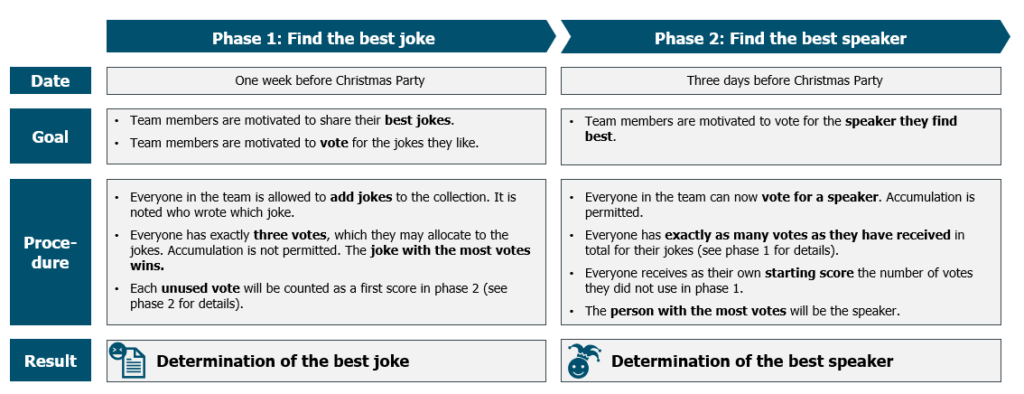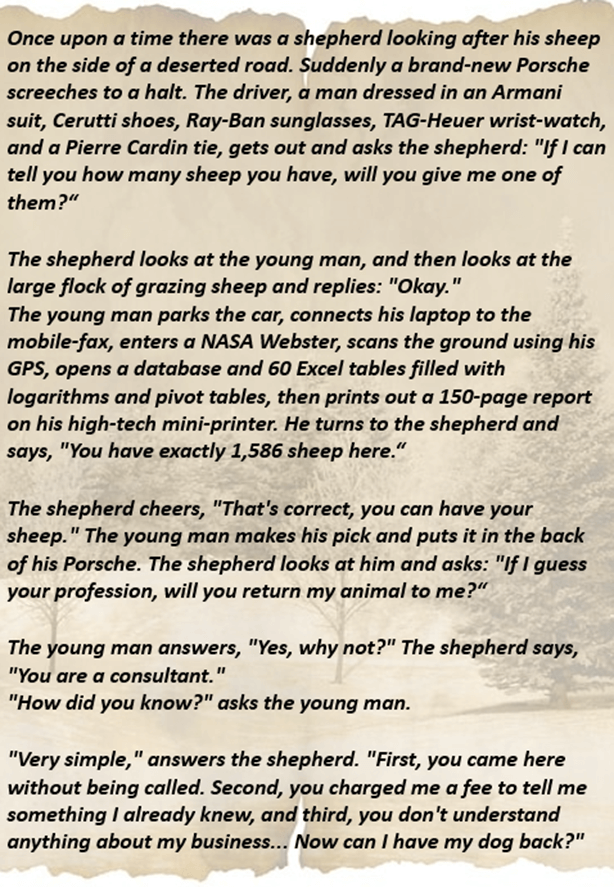The joke competition
To spice up our Christmas Party this year, our colleagues organised a joke competition. This was our one and only opportunity to claim the title of ‘Funniest TWS Team Ever’.
In order to win, we faced two decisive questions
- What joke would blow everyone else out of the water?
- Who possessed the ability to deliver such a masterpiece?
To answer these questions, we focused on our core competence of mechanism design. In the spirit of mechanism design, we developed a set of clear rules which incentivised people to voluntarily contribute quality jokes and then vote on them.
Design to decision
Given the nature of the problem at hand, we opted for a two-stage voting system which addressed each question sequentially, in a separate phase. Phase 1 identified the best joke and phase 2 identified the best speaker for the selected joke.
While these two questions could have been answered in a simple simultaneous round of voting, it would not have encouraged people to participate, as staying quiet is a dominant outside option (especially in the busy pre-Christmas period). The phases of our two-stage voting system built upon each other to transform the fear of presenting into creativity when it comes to proposing jokes. Furthermore, by answering the questions sequentially, a perfect speaker for the winning joke was able to be found.
Before the start of phase 1, a trustworthy and confidential ‘Game Master’ needed to be picked to keep track of all entered jokes and the evaluation of both phases.

Design to decision
Design phase 1
The aim of phase 1 is to collect jokes and identify the best one. Additionally, phase 1 aims at scoring all proposed jokes to lay the foundation for phase 2.
For phase 1 we asked all team members to contribute jokes. Each team member is allowed to add as many jokes as they like, and it is noted by the Game Master who contributed which joke.
Then, team members were asked to publicly score all contributed jokes. Everyone has got exactly three votes which can be allocated to any of the jokes (accumulation is not permitted). If someone is not using all of their three votes, the unused votes will be counted as a penalty in phase 2.
At the end of phase 1, the votes for each joke and the remaining votes per person are added. Each joke then has an individual score of votes and the joke with the most votes wins. Each person has an individual score of unused votes.
In case of a tie (i.e. two jokes have the same number of votes), the joke submitted first wins.
Design phase 2
Having determined the best joke, the challenge to find a speaker who delivers the joke flawlessly remains. Phase 2 tackles this challenge, taking into account all information gathered during phase 1.
The mechanism used in Phase 2 is a modified plurality voting system, i.e., the person with the most votes wins. In our voting system, every team member has an individual number of castable votes. This number is the sum of all votes during phase 1 that were placed on the jokes of the respective team member.
These votes can be distributed across all team members while accumulation of votes is permitted. Each team member communicates their vote allocation covertly to the Game Master.
In addition to all allocations during phase 2, the Game Master considers individual penalties from phase 1. Each penalty is equal to the individual number of unused votes during phase 1 (see example below.)
The final allocation is the sum of all individual allocations and the penalties from phase 1. The team member with the highest score within this final allocation is chosen as the speaker.
In case of a tie (i.e. two people have the same number of votes), the person voted for by more different team members wins.
In case of another tie, the Game Master will decide on the speaker.

Example: Result phase 1 and procedure phase 2 for Alice
Incentive analysis
The objectives of the two-stage voting system is to incentivise
- sharing quality jokes
- truthfully ranking proposed jokes and speakers
- early participation
- independent votes, aka fight collusion
To find the best joke we relied on swarm intelligence. Since this requires sharing quality jokes as the fundamental condition, we placed a strong emphasis on the first objective.
Firstly, by conditioning the number of available votes during phase 2 on the sum of received votes during phase 1, it is in everyone’s interest to maximise the number of votes received during phase 1. This system rewards people that contribute many good jokes with a bigger impact in determining the speaker. As most team members did not want to end up as the speaker, this greatly increased the number of good jokes submitted.
Secondly, in phase 1 we opted for public voting, while additional jokes could still be added to spice it up by additional dynamics. Observing well-performing jokes might inspire people to contribute additional jokes.
Thirdly, banning the accumulation of votes during phase 1 encourages people to contribute multiple jokes, as this is the only way of gathering multiple votes from the same person. While this restriction also attempts to stop people from voting for their own joke only, it requires additional effort in the form of reading time. Hence, this approach is prone to people casting only a single vote. To mitigate this shortcoming, we introduced the penalties during phase 2, which had a fortunate side effect on our second objective.
To receive plentiful and truthful feedback on the jokes, it was important to make it in everyone’s interest to give feedback and ensure that the feedback is not dependent on personal friendships.
The former was achieved by introducing the penalty in phase 2, as any unused vote in phase 1 increased the chance of being selected as the speaker. If most people prefer not to be the speaker, they’d rather vote for three jokes than present a joke in front of the entire company. The latter was achieved by keeping the jokes’ authors’ information private, confidentially stored with the Game Master, while the voting in phase 1 took place publicly.
By keeping phase 2’s voting secret, people could freely vote without considering harsh retaliations.
Knowing the team, we expected plenty of late entries. Therefore, we grouped the joke suggestion and voting together in phase 1. This gave early contenders a better chance as more team members read the joke and considered voting for it. Furthermore, in the early stages there is less competition.
The last objective of making collusion unattractive was the most difficult to address, as people could coordinate in the background. To make such behaviour less stable, and consequently less attractive, we opted for covert voting in phase 2. This way, colluders could not explicitly oversee whether everyone stuck to the agreement, creating the opportunity to deviate from the agreement and vote independently for anyone. In addition, the tiebreaker in phase 2 ensured that collective agreements, which consist of jointly placing all votes on one person, are useless in case of doubt. If there was a second person with the same number of votes, the one who got their votes through more different people would be elected.
Summary
Our tailor-made two-stage voting system identified the best joke of all the jokes our team members had in mind, and it pinpointed the ideal speaker to deliver the joke at the TWS Christmas competition.
Although this competition was just for fun, our motto still applied: Incentives matter
Reactions and feedback
Our team’s reactions show that this two-stage voting mechanism incentivised participation. The most common response was “Damn you guys, if I follow through with my current strategy of keeping a low profile during the entire process, I run the risk of being nominated for presenting the joke”. This view is supported by the number of contributed jokes, which was an average of 1 to 2 jokes per person, and the voting behaviour, as only very few people did not make use of all their votes. In general, one could gradually sense curiosity building up as the competition gained traction.
However, the most surprising reaction was the degree of internal discussions. Based on hearsay, a lot of alignment has been going on in the background. In practice, our anti-collusion levers did not work as hoped since the trust between colluders was much stronger than expected and the case of a tie in phase 2 unlikely. In future, an additional lever needs to be included. While this collusive behaviour might have affected the final outcome, it did not change the fact that the proposed mechanism fulfilled the goal of motivating the team.
Result
In general, the process worked as expected. Not only were we very engaged as a team, but we actually found an extremely good joke. We defined a humorous person who matched this joke best and our incentives have done the trick.
Our speaker performed well at the TWS Christmas Party, but unfortunately our team did not win. Nevertheless, we heard a lot of very good jokes that evening, thanks to the entire TWS team and the organisers of the TWS Christmas competition! We had a lovely (and funny) evening.
We don’t want to keep you in the dark any longer and would now like to present the winning joke of the evening. Congratulations!

